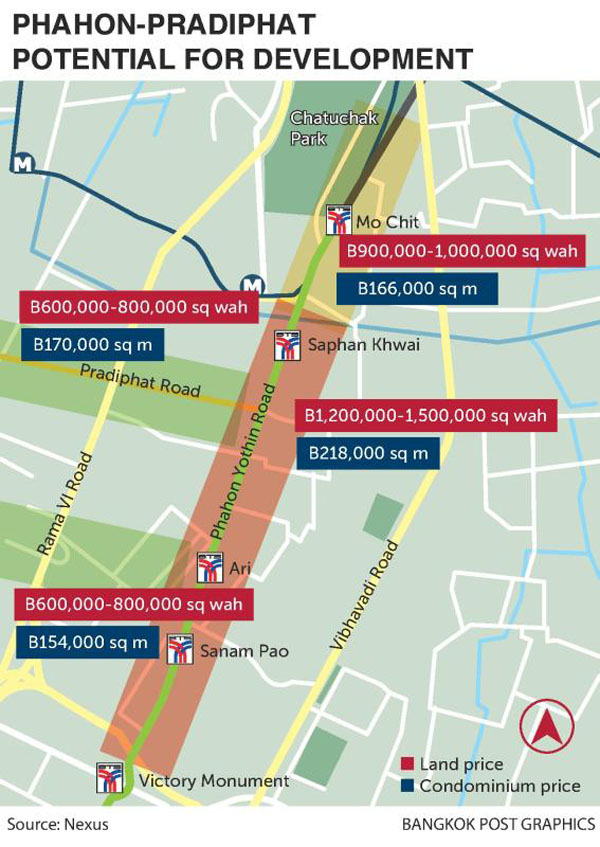Phahon Yothin-Pradiphat has become the latest potential area for development, offering prices below nearby areas on Phahon Yothin Road with similar travel times and environment, says consultant Nexus Property Marketing Co.
Managing director Nalinrat Chareonsuphong said the Pradiphat area is now a trendy location.
The Phahon Yothin-Pradiphat area has an old Bangkok feel, with hotels, shops and restaurants operating in 3-4 storey commercial buildings along Pradiphat Road.
Urban growth over the past several years has increased the property developer’s potential in this area. Land prices on this road range from 600,000-800,000 baht per square wah. The land in nearby areas, including side streets in Ari, Phahon Yothin Road (from Chatuchak to BTS Saphan Khwai), and the strip from BTS Saphan Khwai to Victory Monument cost 600,000-800,000 baht per square wah, 900,000-1 million and 1.2 million-1.5 million baht, respectively.
The average condominium price in the Phahon Yothin-Pradiphat area costs 170,000 baht per square metre, lower than the average price of 218,000 per square metre on Phahon Yothin Road (from BTS Saphan Khwai to the Victory Monument).
Nonetheless, both locations have a similar environment in terms of road size, transport and infrastructure.
For condominiums in nearby areas such as Ari and Chatuchak, the average price per square metre is 154,000 baht and 166,000, respectively.
Although these two locations are not far from Phahon Yothin-Pradiphat, the average condominium price per square metre is lower because most projects in Ari are low-rise condominiums. In addition, those projects in Chatuchak are less central.
Nearby locations, similar environment
The Phahon Yothin-Pradiphat location can be accessed via several routes and modes of transport. It takes 5-10 minutes by car or 10-15 minutes on foot to reach the main Phahon Yothin strip and Rama VI Road. It’s also connected to the Ari area.
The distance to nearest BTS stations, Saphan Khwai and Ari, are the same as for projects which are located between the stations. In addition, the expressways to the inner circle of Bangkok and northern Bangkok or outer ring are within a two-kilometre radius.
The surrounding areas all have public utilities, over 10 department stores and community malls, two large schools, six hospitals, seven government agencies, office buildings, restaurants, cafes and convenience stores.
Continuous development plan
It has been almost 20 years since the BTS Green Line started operations. The skytrain line has linked up northern Bangkok (Chatuchak), the inner circle of Bangkok and the eastern side (Bearing).
The city plan has been changed according to subsequent growth. Most of the areas are brown and partly red, meaning that this zone has high potential for development.
The areas can be developed with horizontal and vertical residences or commercial buildings such as hotels and office buildings.
There are three projects under construction set to be completed and operational by 2020. One is a transport project — the red line mass transit system laying along Kamphaeng Phet 5 Road.
The next development is The Rice by Srisuparat, a mixed-use project by Srisuparat Group, which includes offices, retail space and a four-star hotel.
The other is Vimutti Hospital by Pruksa Holding, located on a seven rai plot.
Other large developments for which operations are set to begin over the next 5-15 years are two mixed-use projects: The Unicorn by BTS Group Holdings, including a sports complex, retail and office buildings; Bangkok Terminal, including offices, hotels, serviced apartments, parking lots and a transport hub; and Bangsue Grand Station covering 218 rai, which has been built according to the Transit Oriented Development Plan to become an Asean railway hub.

(Source: Bangkok Post)